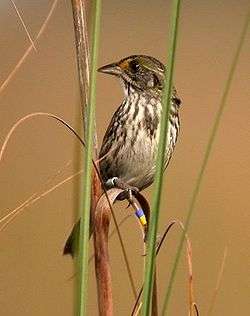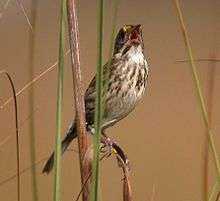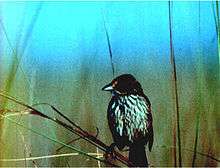Cape Sable seaside sparrow
| Cape Sable seaside sparrow | |
|---|---|
 | |
| Cape Sable seaside sparrow in Everglades National Park. This individual (UCLA, so named because of his blue and gold color bands) was part of a demographic study looking at the effects of fire on sparrow abundance and nest success. | |
| Scientific classification | |
| Kingdom: | Animalia |
| Phylum: | Chordata |
| Class: | Aves |
| Order: | Passeriformes |
| Family: | Emberizidae |
| Genus: | Ammodramus |
| Species: | A. maritimus |
| Subspecies: | A. m. mirabilis |
| Trinomial name | |
| Ammodramus maritimus mirabilis (Howell, 1919) | |
The Cape Sable Seaside Sparrow (Ammodramus maritimus mirabilis) is a subspecies of seaside sparrow endemic to southern Florida.
Overview
The largest populations are found in Taylor Slough in Everglades National Park and in the Big Cypress Swamp. The species is considered endangered due to habitat loss from vegetation changes, fire, development, alteration of water flow, and hurricanes.


Cape Sable seaside sparrows are about 13 centimeters (5 inches) long. The back is dark olive-gray and the tail and wings are olive-brown. Adults are light gray on the belly to almost white with dark olive-gray streaks on the breast and sides.
The Cape Sable seaside sparrow lives on the prairies of the Everglades and the Big Cypress Swamp. (Prairies are grasslands subject to frequent fires which limit the growth of trees. Dry prairies flood after heavy rains. Wet prairies are flooded from two to five months each year.[1]) Specific habitats for the sparrows on the prairies are stands of muhly grass (Muhlenbergia filipes), short sawgrass (Cladium jamaicense), tall, clumped cordgrass, and relatively sparse low cordgrass.
In August 2013, Duke University scientist Stuart Pimm and the Center for Biological Diversity announced filing of a lawsuit against the U.S. Army Corps of Engineers and U.S. Fish and Wildlife Service. At issue was the continuing release of water flooding the Cape Sable seaside sparrow's habitat. The lawsuit alleged the practice to be in violation of the Endangered Species Act.[2]
References
- ↑ Prairies - Accessed February 11, 2008
- ↑ Center for Biological Diversity Press Release (August 13, 2013). "Lawsuit Launched Challenging Ongoing Flooding of Endangered Cape Sable Seaside Sparrow Habitat and Everglades National Park". Retrieved August 13, 2013.

